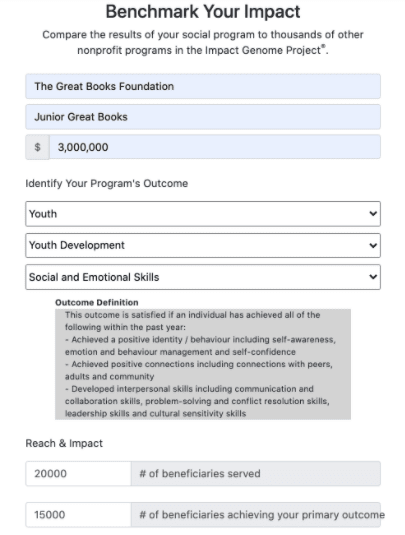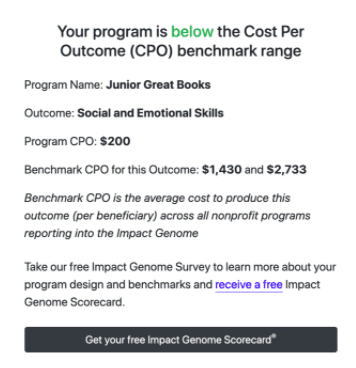There are few aspects of nonprofit management as vexing as measurement. Measuring your progress on achieving your mission is complex, challenging, and it can be costly. With that in mind, it’s no surprise that many organizations default to measuring things they can more easily get their heads around, such as people served, dollars donated, new donors gained or lost, members recruited or retained, and money spent on overhead. These numbers may be important, but they alone aren’t indicators of mission impact. Organizations can and do have seemingly stellar years where they exceed their fundraising goals, keep their costs down, serve more people than ever and yet fail to meaningfully advance the goals implicit in their missions.
[bctt tweet=”Organizations can and do have seemingly stellar years where they exceed their fundraising goals, keep their costs down, serve more people than ever and yet fail to meaningfully advance the goals implicit in their missions. ” username=”ProsperStrat”]That said, it’s also misguided to tie every metric your organization tracks to mission outcomes. Organizations that take that approach may have a clear understanding of whether they’re making progress toward their missions, but they lack clarity on what factors are driving their success (or struggle) and have difficulty making adjustments to course correct when necessary.
That’s why a well-rounded and effective approach to nonprofit impact measurement looks at both mission outcomes and the factors that drive those outcomes by focusing on three important categories of metrics:
- Objectives and Key Results (OKRs), which indicate the ability of an organization’s staff to fulfill the responsibilities of their jobs
- Organizational Health Metrics (OHMs), which indicate whether an organization has the financial and structural foundation required to carry out its mission
- Mission Outcome Metrics (MOMs), which indicate whether an organization is making progress toward its mission, and how much
While an entire blog post could be written about each of these types of impact measurement alone (and in that spirit, you’ll see more content from us on this in the coming months), today I’d like to provide a primer on what each type of impact measurement looks like and how you can begin employing it at your organization.
Objectives and Key Results (OKRs) – people effectiveness indicators
Objectives and key results are a darling of the tech world, first popularized by organizations like Google and Intel, but nonprofits have started to adopt this type of measurement in droves simply because it is so effective at holding every person on a team accountable to the most important responsibilities and goals associated with their jobs.
Here’s how OKRs are defined by our friends at Wikipedia:
“OKRs comprise of an objective—a clearly defined goal—and 3-5 key results—specific measures used to track the achievement of that goal. The goal of OKR is to define how to achieve objectives through concrete, specific and measurable actions Key results can be measured on a 0-100% scale or any numerical unit (e.g. dollar amount, %, items, etc.). Objectives should also be supported by initiatives, which are the measurable plans and activities that help to achieve the objective and move forward the key results.”
While OKRs can be used on a team or department-wide level, they’re particularly useful when implemented on an individual level, for each member of an organization’s staff. This requires establishing a strategic plan with clearly defined organization-wide goals. Then, using that strategic plan to inform the development of a plan for every one of your organization’s key programs and departments (including marketing/communications and fundraising/development). Once you do this, you can set individual OKRs based on those plans to make sure everyone is playing their part in carrying your organization’s strategy forward. OKRs fit in nicely to the Nonprofit Strategy System because you can use the Progress elements of the System to build in additional layers of accountability.
Organizational Health Metrics (OHMs) – financial and structural effectiveness indicators
No matter its size, mission or focus, there are common performance metrics that indicate whether an organization has a sound financial and structural foundation on which it can carry out its mission.
Some examples of these metrics include:
- Months of cash on hand
- Revenue per full-time employee
- New donor acquisition vs. donor attrition rate
- Diversity of funding sources
For each of these OHMs, there are benchmarks (based on data from many nonprofits) that when met, indicate your organization has a healthy financial and structural foundation, and when missed, indicate you will have trouble carrying out our mission.
We’re currently working on a Nonprofit Metrics Dashboard tool that will detail these metrics and their associated benchmarks in far greater depth. Please stay tuned for its release in July.
Mission Outcome Metrics (MOMs) – impact indicators
Mission Outcome Metrics are the holy grail of nonprofit impact measurement, but they don’t mean much unless they can be understood in the context of OKRs and OHMs, which tell us a great deal about not only whether an organization is progressing in its mission, but why it is or isn’t making progress. A mission outcome metric is simply a metric that measures your organization’s progress toward carrying out its mission, as defined in its mission statement. But defining a Mission Outcome Metric is far easier than establishing your organization’s own MOMs and measuring them accurately.
There are many tools and approaches that can help, but one of our favorites is the Impact Genome from Mission Measurement. The Impact Genome has created a taxonomy for understanding social change and a universal standard for measuring it.
Using the Impact Genome, you can choose your organization’s mission area (ex: the environment, education) and then choose from a highly detailed taxonomy of different sorts of impact areas and outcomes you may be focused on driving for each of your programs, compiled through the analysis of thousands of nonprofits. The Impact Genome helps you define the outcomes you’re focused on driving, and then asks you to share information on the number of beneficiaries served by the program you’re evaluating, and the number of those beneficiaries achieving the intended outcome. Let’s take a look at an example for The Great Books Foundation, an education nonprofit we work with regularly, and their Junior Great Books program. Note: all numbers are for example purposes only and do not represent the organization’s reality. Here’s an example of what they entered into the tool.

Again, here’s an example of what this could look like for an organization like The Great Books Foundation:
 In this example, we’re looking at only one of the types of outcomes defined in their mission (social and emotional skills), but we could repeat this process for the other two types of outcomes (critical thinking and leadership). See their mission statement broken down by outcomes below.
In this example, we’re looking at only one of the types of outcomes defined in their mission (social and emotional skills), but we could repeat this process for the other two types of outcomes (critical thinking and leadership). See their mission statement broken down by outcomes below.
 Not only does The Impact Genome define and codify the types of outcomes you might be focused on driving based on your mission, but it also gives you an accessible way to measure your efficiency in reaching those outcomes based on the money you’re spending as an organization to produce results.
Not only does The Impact Genome define and codify the types of outcomes you might be focused on driving based on your mission, but it also gives you an accessible way to measure your efficiency in reaching those outcomes based on the money you’re spending as an organization to produce results.
Of course, the Impact Genome isn’t a perfect system. Cost efficiency isn’t the only measure that matters when it comes to driving impact. But the Genome is far less complex than many of the alternatives we’ve tested for measuring mission outcomes and presents a great starting point for organizations that want to dip their toes into the murky waters of mission outcome measurement.
Now, we’d love to hear from you.
How is your organization handling measurement? What are you confused or frustrated by? Again, we’ll be delving into this topic far more with our content in the coming weeks and look forward to co-creating better approaches to measurement with you.